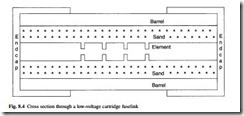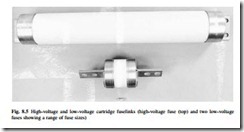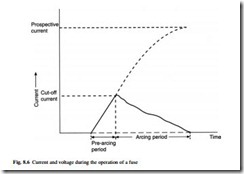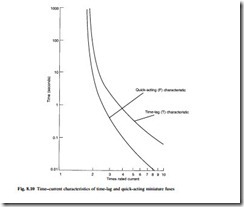Fuses
Principles of design and operation
A fuse consists of a replaceable part (the fuselink) and a fuse holder. Examples of fuse holders are shown in Fig. 8.3.
The simplest fuselink is a length of wire. It is mounted by screw connections in a holder which partly encloses it. When an overcurrent or short-circuit current flows, the wire starts to melt and arcing commences at various positions along it. The arc voltage causes the current to fall and once it has fallen to zero, the arcs are extinguished. The larger the wire cross section, the larger is the current that the fuselink will carry without operating. In the UK, fuses of this type are specified for use at voltages up to 250 V and currents up to 100 A. They are known as semi-enclosed or rewireable fuses.
The most common fuselink is the cartridge type. This consists of a barrel (usually of ceramic) containing one or more elements which are connected at each end to caps fitted over the ends of the barrel. The arrangement is shown in Figs 8.4 and 8.5. If a high current breaking capacity is required, the cartridge is filled with sand of high chemical purity and controlled grain size. The entire fuselink is replaced after the fuse has operated and a fault has been disconnected. Cartridge fuses are used for a much wider range of voltages and currents than semi-enclosed fuses.
Fuselinks can be divided into current-limiting and non-current-limiting types. A sand-filled cartridge fuselink is of the current-limiting type; when it operates, it limits the peak current to a value which is substantially lower than the prospective current. A non-current-limiting fuse, such as a semi-enclosed fuse, does not limit the current significantly.
The element shown in Fig. 8.4 is a notched tape. Melting occurs first at the notches when an overcurrent flows and this results in a number of controlled arcs in series. The voltage across each arc contributes to the total voltage across the fuse, and this total voltage results in the current falling to zero. Because the number of arcs is limited, the fuselink voltage should not be high enough to cause damage elsewhere in the circuit. The characteristic development of current and voltage during the operation of a fuse is shown in Fig. 8.6.
The function of the sand is to absorb energy from the arcs and to assist in quenching them; when a high current is disconnected, the sand around the arcs is melted.
The element is usually of silver because of its resistance to oxidation. Oxidation of the element in service would affect the current that could be carried without melting, because the effective cross section of the element is changed. Silver-plated copper elements are also used.
Many elements include an m-effect blob, which can be deposited on wire (Fig. 8.3(b)) or notched tape. The blob is of solder-type alloy which has a much lower melting point than the element. If a current flows which is large enough to melt only the m-effect blob, the solder diffuses into the silver. This creates a higher local resistance in the element and the fuse operates at a lower current than it would have done in the absence of the blob.
Other types include the expulsion fuse which is used at high voltage, and the universal modular fuse (UMF) which is used on Printed Circuit Boards (PCBs).
Fuses offer long life without deterioration in their characteristics or performance, and cartridge fuses have the particular advantage that they contain the arc products completely.
Rating principles and properties
(a) Current ratings (IEC)
The rated current of a fuse is the maximum current that a fuselink will carry indefinitely without deterioration. In the case of ac ratings, an rms symmetrical value is given.
The current rating printed on a fuselink applies only at temperatures below a particular value. Derating may be necessary at high ambient temperatures and where fuses are mounted in hot locations, such as an enclosure with other heat-generating equipment.
It is obviously undesirable to have a proliferation of current ratings and therefore particular or preferred ratings are specified in standards. There is a general tendency, particularly in the IEC standards, to follow the R10 series or, if necessary, the R20 series may be used. For example, using the R10 series fuselinks with ratings from 10 A to 100 A are produced for 10 A, 12 A, 16 A, 20 A, 25 A, 32 A, 40 A, 50 A, 63 A, 80 A and 100 A. In the USA, more traditional ratings including 15 A, 30 A and 60 A are used.
(b) Voltage ratings (IEC)
The rated voltage of a fuse is the nominal voltage for which it was designed. Fuselinks will perform satisfactorily at lower voltages, but at much lower voltages, the reduction in current caused by the resistance of the fuselink should be considered. In the case of ac ratings, the rms symmetrical value is given, and for dc ratings the mean value, including ripple, is given.
IEC recommendations are moving towards harmonized low-voltage ac supplies of 230 V, 400 V and 690 V, but although the nominal voltage is being changed in many countries it will be possible for the voltage to remain at its previous non-harmonized level for several years. In Europe, the nominal voltage is 230 V, and the permitted variations will allow supplies to remain at 240 V and 220 V. Fuselinks marked 230 V may have been designed originally for use with higher or lower voltages, and problems may therefore arise when replacing fuselinks because a device manufactured for use at 220 V would not be safe to use on a 240 V system. A fuselink designed for 240 V could safely be used at 220 V. Similar considerations apply where the voltage is changed from 415 V to 400 V, or 660 V to 690 V.
(c) Variations in rating principles
The IEC rating principles are used worldwide, except in North America, where UL (Underwriters Laboratory) standards apply.
The rated current to a UL standard is the minimum current required to operate the fuse after many hours, and the current that it will carry indefinitely (the IEC rated current) is approximately 80 per cent of this rating.
The voltage rating marked on a UL fuselink is the maximum voltage at which it can be used, whereas that marked on an IEC fuselink is the nominal voltage.
These differences must be considered when replacing fuselinks, particularly in the case of miniature cartridge fuselinks which are interchangeable. In general, it is preferable to replace a fuselink with one of the same rating from the same manufacturer; this ensures that its characteristics are as similar as possible to those of the previous fuselink.
The IEC and UL ratings of fuse holders also differ. The IEC rating is the highest rated current of a fuselink with which it is intended to be used. A higher rating may be given in North America, this being related to the maximum current that does not cause overheating when a link of negligible resistance is used.
(d) Frequency ratings
Fuses are most commonly used in ac circuits with frequencies of 50 Hz or 60 Hz and a fuse designed for one of these frequencies will generally operate satisfactorily at the other. If the arc extinguishes at current zero, then the maximum arcing time on a symmetrical fault will be 10 ms at 50 Hz and 8 ms at 60 Hz.
Fuse manufacturers should be consulted about the suitability of fuses for other frequencies, which may include 17.67 Hz for some railway supplies, 400 Hz for aircraft and higher frequencies for some electronic circuits.
In dc circuits there is no current zero in the normal waveform and the fuselinks designed for ac may not operate satisfactorily. Separate current and voltage ratings are given for fuselinks tested for use in dc circuits. DC circuits can be more inductive for a given current than ac systems, and since the energy in the inductance is dissipated in the fuse, it is necessary for the dc voltage rating to be reduced as the time constant (L/R) of a circuit increases.
(e) Breaking capacity
The breaking capacity of a fuse is the current which can be interrupted at the rated voltage. The required breaking capacity will depend upon the position of the fuse in the supply system. For instance, 6 kA may be suitable for domestic and commercial applications, but 80 kA is necessary at the secondary of a distribution transformer.
The power factor of a short circuit affects the breaking capacity, and appropriate values are used when testing fuses.
(f) ) Time–current characteristics
The time–current characteristic of a fuse is a graph showing the dependence upon current of the time before arcing starts (the pre-arcing time); an example has been shown in Fig. 8.2. The total operating time of a fuse consists of the pre-arcing time and the arcing time. When pre-arcing times are longer than 100 ms and the arc is then extinguished at its first current zero (that is, an arcing time of less than 10 ms on a 50 Hz supply) then the time–current characteristic can be taken to represent the total operating time.
The conventional time, the conventional fusing current and the conventional non- fusing current are often shown on time–current characteristics. These values are defined in the standards. All fuses must operate within the conventional time when carrying the conventional fusing current; when carrying the conventional non-fusing current they must not operate within the conventional time.
Specific characteristic curves have not been standardized because the constraints which might be imposed by doing so could stifle future development and prevent the introduction of new fuses with slightly different time–current characteristics. The modern trend is to specify a number of points which form gates through which the actual time–current characteristics of all manufacturers’ fuselinks must pass if they are to comply with the appropriate standard. Such gates apply to current IEC miniature fuse standards. In addition to gates, some of the IEC standards on low-voltage fuses specify zones within which all characteristics must lie. The zones are specified so that all fuselinks of a given rating would operate in a shorter time at any current than any fuselink of at least 1.6 times the rating (two steps in the R10 series).
(g) I 2t
I 2t is defined as the integral of the square of the current let through by a fuse over a period of time. Values are given by manufacturers for pre-arcing I 2t and total let-through I 2t.
Table 8.1 shows typical values of I 2t for low-voltage cartridge fuses of selected current ratings; values differ between manufacturers.
The heat generated in a circuit in a short circuit or fault condition before the fuse disconnects is given by the product of I 2t and the circuit resistance. As the let-through I 2t becomes constant above a particular level of fault current, the heat generated does not increase for prospective currents above this value, unless the breaking capacity is exceeded.
(h) Power dissipation
The resistance of a fuse will result in dissipation of power in the protected circuit when normal currents are flowing. This should be considered when designing the layout of a protection system.
(i) Cut-off current
A current-limiting fuse prevents a fault current from rising above a level known as the cut-off current. This is illustrated in Fig. 8.6. The cut-off current is approximately proportional to the cube root of the prospective current, and the maximum current is therefore very much lower than it would be if a non-current-limiting protection device were used.
Main classes of equipment
Fuses are produced in many shapes and sizes, and various types are illustrated in Figs 8.5, 8.7, 8.8 and 8.9. The main three categories are:
● miniature (up to 250 V)
● low voltage (up to 1000 V ac or 1500 V dc)
● high voltage (greater than 1000 V ac)
All three categories include current-limiting and non-current-limiting types.
(a) Miniature fuses
Cartridge fuses have in the past been the most common form of miniature fuse, but the UMF (see Fig. 8.7) is becoming increasingly used on PCBs. A UMF is much smaller than a cartridge fuse, and it is mounted directly on the PCB, whereas a cartridge fuse is mounted in a holder. Subminiature fuses have pins for mounting on PCBs.
Miniature cartridge fuses and subminiature fuses are rated for use at 125 V or 250 V. The UMFs have additional voltage ratings of 32 V and 63 V which make them more suitable for many types of electronic circuit. Miniature fuses are available with current ratings from 2 mA to 10 A. The maximum sustained power dissipation which is per- mitted in cartridge fuses ranges from 1.6 W to 4 W.
Miniature fuses may have a low, intermediate or high breaking capacity. All three ranges are available for UMFs, and these are given in Table 8.2.
Cartridge fuses are available with low or high breaking capacity. Low breaking capacity types have glass barrels without sand-filler and a visual check can therefore be made on whether or not the fuse has operated. High breaking capacity cartridge fuselinks are generally sand-filled and have ceramic barrels; they can interrupt currents of up to 1500 A.
A range of speeds of operation are available. Time-lag (surge-proof ) fuses are required in circuits where there is an inrush current pulse, for instance when capacitors are charged or when motors or transformers are magnetized. The fuse must not be operated by these normal-operation surges, which must not cause deterioration of the fuse. The five categories of time-lag are medium time-lag (M), time-lag (T), long time- lag (TT), very quick-acting (FF) and quick-acting (F). They are available as cartridge fuses and the last two are used in the protection of electronic circuits. The alphabets shown in parentheses are marked on the endcaps.
The UMFs are available in similar categories, which are super quick-acting (R), quick-acting (F), time-lag (T) and super time-lag (S).
The time–current characteristics of miniature fuses of the same type but with different ratings are similar in shape. Time can therefore be plotted against multiples of rated current and it is unnecessary to show separate characteristics for each current rating. Examples of time–current characteristics are shown in Fig. 8.10.
Cartridge fuses have various types of elements. Fast-acting types have a straight wire, and time-delay types use wire with an m-effect blob (Fig. 8.3(b)), helical elements on a heat-absorbing former or short elements with springs connecting them to the endcaps.
In addition to the most common types which have been described, miniature fuses are produced in a wide range of shapes and sizes. As an example of this, a blade-type
automotive fuselink is shown in Fig. 8.8; the element in this fuse is visible through the plastic casing.
(b) Low-voltage fuses
A wide range of low-voltage fuses are available for industrial and domestic applica- tions. These fuses have ratings appropriate for national or international single-phase or three-phase supplies, for example 220 V, 230 V, 240 V, 400 V, 415 V, 660 V and 690 V. Widely differing systems for domestic protection are used in different countries and these cannot be described separately here. As an example, in the UK current- limiting cartridge fuses are used in plugs which supply appliances, the consumer unit supplying an entire property may have current-limiting cartridge fuses, semi-enclosed fuses or miniature circuit breakers and another fuse is installed by the supply authority on the incoming supply.
Industrial fuses may have general-purpose (type ‘g’) fuselinks which will operate correctly at any current between 1.6 times the rated current (the conventional fusing current) and the breaking capacity. Such fuses must not be replaced by type ‘a’ back-up fuselinks, which have a higher minimum breaking current and do not necessarily operate safely below this current; this type ‘a’ back-up fuselink is used to save space.
Type ‘gG’ fuses are used for general application. These have a full breaking capacity range and they provide protection for cables and transformers and back-up protection for circuit breakers. Specialized fuses are available for the protection of motors, semiconductors, street lighting, pole-mounted transformers and other purposes. Reference 8A provides further detail. Common applications are motor protection and semiconductor protection and these are described briefly.
Fuselinks for motor-starter protection must be able to withstand starting pulses without deterioration. Type ‘gM’ fuselinks are designed for this purpose and they have a dual rating. A designation 100M160, for example means that the fuselink has a continuous rating of 100 A and the general-purpose characteristics of a fuselink rated at 160 A.
Fuselinks for semiconductor protection are designed to operate with an arc voltage which does not damage the semiconductor device; this voltage is therefore lower than for other types of fuselink. Arc voltages at several supply voltages are shown in Table 8.3 for typical semiconductor fuselinks.
Semiconductor fuselinks also have lower let-through I 2t and cut-off current because semiconductors are susceptible to damage by heat and overcurrents. These fuses operate at higher temperatures than normal to achieve the necessary protection, and forced air-cooling may be used to increase their current rating.
(c) High-voltage fuses
High-voltage fuses can be of current-limiting or non-current-limiting type. The latter are expulsion fuses which do not contain the arc products when they operate; they can be very noisy and are therefore normally used outdoors.
Current-limiting high-voltage fuses are enclosed (as already shown in Fig. 8.5) and they may be used for the protection of motors, transformers and shunt power capacitors. The rated current of the fuselink is normally higher than the expected current. These fuses are normally used in three-phase systems and they are tested at 87 per cent of their rated voltage. In a three-phase earthed neutral system the voltage rating should be at least 100 per cent of the line-to-line voltage, and in a single-phase system it should be at least 115 per cent of the circuit voltage.
Further information can be found in references 8A, 8B and 8C.
Test methods
(a) Type tests
Before production of a type of fuselink commences, type tests are performed to ensure that pre-production fuselink samples comply with relevant national or international standards. Measurements of power dissipation, time–current characteristic, overload withstand capability, breaking capacity and resistance are included in these type tests.
(b) Production tests
Routine testing of many important fuse characteristics is not possible because tests, such as breaking capacity are destructive. Extensive testing in production would also be very costly. Fuse manufacturers therefore make production fuselinks as identical as possible to the samples used for type testing.
The quality of fuselinks depends upon the quality of the components supplied to the fuse manufacturer. Key items, such as barrels, filling material, element material and endcaps are therefore regularly inspected and tested when received.
The dimensions and straightness of barrels are checked and their ability to withstand mechanical and thermal shock and internal pressure is tested. Endcap dimensions are checked to ensure that they fit closely over the barrel. The moisture content, chemical composition and grain size of the filler are measured. The diameter or thickness of the element wire or tape are checked and its resistance per metre is measured. Where elements are produced from tape and notched, the dimensions and pitch of the notches are tightly controlled.
During assembly, checks are made to ensure that the fuselink is completely filled with sand and that the element resistance is correct. After assembly, the overall dimensions are checked and the resistance is once more measured. A visual check including the markings is then made.
Other tests are made in the case of specialized fuselinks. For example, the conditions of the elements in a high-voltage fuselink is examined using X-ray photography.
In addition to these routine tests, manufacturers may also occasionally take sample fuselinks from production and subject them to some or all of the type tests.
(c) Site checks
Before use, every fuselink should be checked visually for cracks and tightness of endcaps and the resistance should be checked. It should also be checked that the ratings, especially current, voltage, breaking capacity and time–current characteristic, are correct for the application. In the case of semi-enclosed, rewireable fuses, care should be taken to use the appropriate diameter of fuse wire. Fuse holders should be checked to ensure that the clips or means of connection are secure and correctly aligned.
If a fuselink has been dropped onto a hard surface or subjected to other mechanical stress it should not be used; damage may not be visible but it could cause the fuse to malfunction with potentially serious results.
If a fault occurs and the fuselink is overloaded, it should be replaced even if it has not been operated. This situation arises especially in three-phase systems where one or two of the three fuses may operate to clear the fault.
Fuselinks (as opposed to rewireable fuses) cannot be safely repaired; they must always be replaced.
Standards
Many national and international standards exist because of the number of different fuse types.
Tables 8.4, 8.5 and 8.6 summarize the position for miniature, low-voltage and high- voltage fuses, respectively. The IEC recommendations are listed, together with related EN and BS standards and North American standards covering the same field.
In order to comply with the EMC directive, the following statement has been added to most of the UK fuse standards:
Fuses within the scope of this standard are not sensitive to normal electromagnetic disturbances, and therefore no immunity tests are required. Significant electro- magnetic disturbance generated by a fuse is limited to the instant of its operation. Provided that the maximum arc voltages during operation in the type test comply with the requirements of the clause in the standard specifying maximum arc voltage, the requirements for electromagnetic compatibility are deemed to be satisfied.










